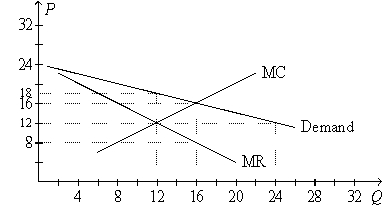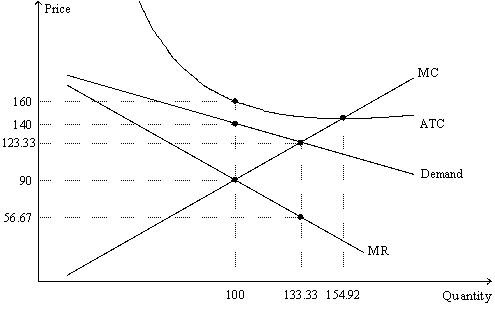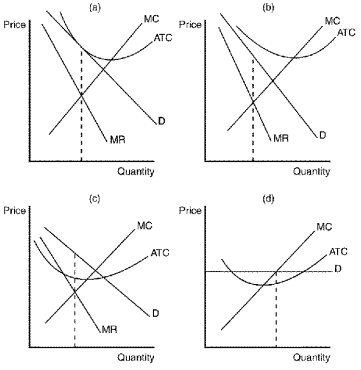A) In the long run,both perfectly competitive firms and monopolistically competitive firms operate with excess capacity.
B) A firm operates with excess capacity when,in the long run,its level of output is below the efficient scale.
C) For any firm,efficient scale is the level of output at which the average-total-cost curve is tangent to the demand curve.
D) All of the above are correct.
Correct Answer

verified
Correct Answer
verified
True/False
Oligopoly and monopolistic competition are examples of a market structure called imperfect competition.
Correct Answer

verified
Correct Answer
verified
Multiple Choice
A monopolistically competitive market is like a competitive market in that
A) both market structures feature easy entry by new firms in the long run.
B) the main objective of firms in both market structures is something other than profit maximization.
C) firms in both market structures produce the welfare-maximizing level of output.
D) firms in both market structures set price above marginal cost.
Correct Answer

verified
Correct Answer
verified
Multiple Choice
Under which of the following market structures would the highest output of a particular good be produced?
A) perfect competition
B) monopolistic competition
C) oligopoly
D) monopoly
Correct Answer

verified
Correct Answer
verified
Multiple Choice
Although monopolistically competitive markets offer consumers a wide variety of differentiated products,there may still be insufficient variety if
A) there are large fixed costs in the market.
B) there are no barriers to entry in the market.
C) the business-stealing externality is present in the market.
D) the government does not impose regulations on the market.
Correct Answer

verified
Correct Answer
verified
True/False
For a profit-maximizing firm in a monopolistically competitive market,when price is equal to average total cost,price must lie above marginal cost.
Correct Answer

verified
Correct Answer
verified
Short Answer
Figure 16-3  -Refer to Figure 16-3.Does this monopolistically competitive market produce the welfare-maximizing level of output?
-Refer to Figure 16-3.Does this monopolistically competitive market produce the welfare-maximizing level of output?
Correct Answer

verified
Correct Answer
verified
Multiple Choice
For a profit-maximizing monopolistically competitive firm,marginal revenue exceeds marginal cost in
A) the short run but not in the long run.
B) the long run but not in the short run.
C) both the short run and the long run.
D) neither the short run nor the long run.
Correct Answer

verified
Correct Answer
verified
Multiple Choice
Figure 16-1.The figure is drawn for a monopolistically competitive firm.  -Refer to Figure 16-1.Suppose ATC = $18 when Q = 12.Then the
-Refer to Figure 16-1.Suppose ATC = $18 when Q = 12.Then the
A) firm is in a long-run equilibrium when it produces 12 units of output.
B) firm is in a long-run equilibrium when it produces 16 units of output.
C) best the firm can do is sustain a loss of $24.
D) best the firm can do is earn a profit of $48.
Correct Answer

verified
Correct Answer
verified
Multiple Choice
Roberto consumes Coke exclusively.He claims that there is a clear taste difference and that competing brands of cola leave an unsavory taste in his mouth.In a blind taste test,Roberto is found to prefer Coke to store-brand cola eight out of ten times.The results of Roberto's taste test would refute claims by critics of brand names that
A) consumers are always willing to pay more for brand names.
B) brand names cause consumers to perceive differences that do not really exist.
C) consumers with the lowest levels of income are the most likely to be influenced by brand name advertising.
D) brand names are a form of socially efficient advertising.
Correct Answer

verified
Correct Answer
verified
Multiple Choice
Evidence suggests that,in markets with differentiated products but little advertising,
A) consumers are not confused by conflicting signals.
B) firms are generally less profitable.
C) markets are less efficient.
D) consumers make better choices.
Correct Answer

verified
Correct Answer
verified
Multiple Choice
If we observe a great deal of advertising of men's shaving products,we can infer that
A) the market for those products is perfectly competitive.
B) it costs firms very little to produce those products.
C) those products are highly differentiated.
D) firms are irrational in their decisions to advertise.
Correct Answer

verified
Correct Answer
verified
Multiple Choice
Figure 16-9
The figure is drawn for a monopolistically-competitive firm.  -Refer to Figure 16-9.In order to maximize its profit,the firm will choose to produce
-Refer to Figure 16-9.In order to maximize its profit,the firm will choose to produce
A) 100 units of output,and its profit will be negative.
B) 100 units of output,and its profit will be zero.
C) 133.33 units of output,and its profit will be negative.
D) 133.33 units of output,and its profit will be zero.
Correct Answer

verified
Correct Answer
verified
Multiple Choice
When a monopolistically competitive firm is in long-run equilibrium,
A) marginal revenue is equal to marginal cost.
B) price is equal to average total cost.
C) demand is equal to average total cost.
D) All of the above are correct.
Correct Answer

verified
Correct Answer
verified
Multiple Choice
Figure 16-9
The figure is drawn for a monopolistically-competitive firm.  -Refer to Figure 16-9.In order to maximize its profit,the firm will choose to produce
-Refer to Figure 16-9.In order to maximize its profit,the firm will choose to produce
A) 100 units of output.
B) between 100 and 133.33 units of output.
C) 133.33 units of output.
D) 154.92 units of output.
Correct Answer

verified
Correct Answer
verified
Multiple Choice
Figure 16-1.The figure is drawn for a monopolistically competitive firm.  -Refer to Figure 16-1.If the ATC=20 at the profit-maximizing level of output,which of the following will occur in the long run in this industry?
-Refer to Figure 16-1.If the ATC=20 at the profit-maximizing level of output,which of the following will occur in the long run in this industry?
A) Firms will exit this industry.
B) Firms will enter this industry.
C) This firm will continue to earn positive economic profits.
D) This firm will incur losses.
Correct Answer

verified
Correct Answer
verified
Multiple Choice
A business-stealing externality is
A) an externality that is likely to be punished under antitrust laws.
B) the negative externality that occurs when one firm attempts to duplicate exactly the product of a different firm.
C) an externality that is considered to be an explicit cost of business in monopolistically competitive markets.
D) the negative externality associated with entry of new firms in a monopolistically competitive market.
Correct Answer

verified
Correct Answer
verified
Multiple Choice
Table 16-1
The following table shows the percentage of output supplied by the top eight firms in four different industries.
 -Refer to Table 16-1.What is the concentration ratio in Industry Z?
-Refer to Table 16-1.What is the concentration ratio in Industry Z?
A) 36%
B) 51%
C) 62%
D) 67%
Correct Answer

verified
Correct Answer
verified
Multiple Choice
Which of the following statements is correct?
A) Firms in monopolistic competition and monopoly can earn economic profits in both the short run and the long run.
B) Both perfectly competitive and monopolistically competitive firms are price takers.
C) Both a monopolistically competitive industry and a monopoly are characterized by a very small number of (or one) firm(s) .
D) Firms can easily enter a perfectly competitive or monopolistically competitive industry.
Correct Answer

verified
Correct Answer
verified
Multiple Choice
Figure 16-4  -Refer to Figure 16-4.Panel a shows a profit-maximizing monopolistically competitive firm that is
-Refer to Figure 16-4.Panel a shows a profit-maximizing monopolistically competitive firm that is
A) earning zero economic profit.
B) likely to exit the market in the long run.
C) producing its efficient scale of output.
D) not maximizing its profit.
Correct Answer

verified
Correct Answer
verified
Showing 281 - 300 of 521
Related Exams